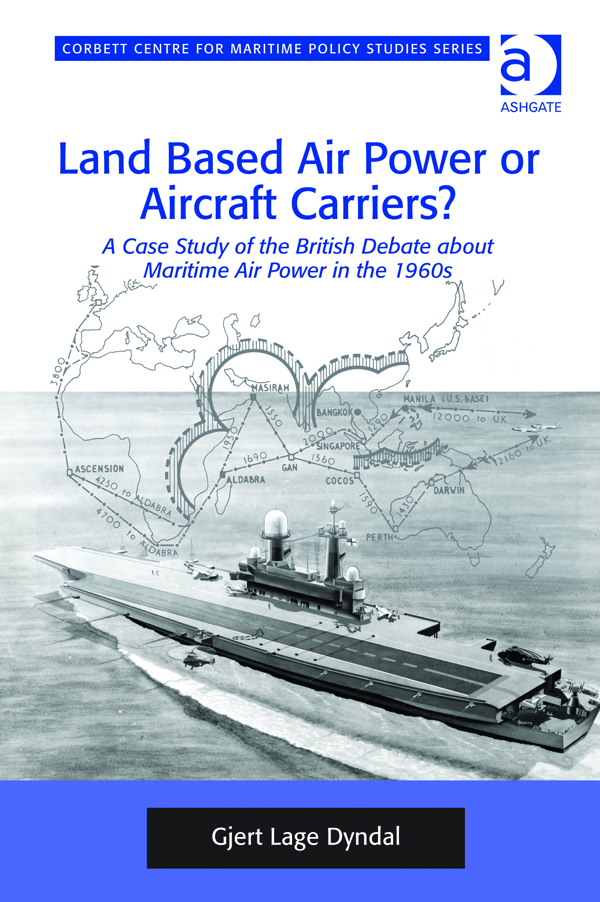
Land Based Air Power or Aircraft Carriers?
A Case Study of the British Debate about Maritime Air Power in the 1960s
by Gjert Lage Dyndal
ISBN 978-1-4094-3335-4
Ashgate Publishing both in the UK and USA
www.ashgate.com
180 pages, 5 maps, 4 photographs
Reviewed by David Hobbs
THIS IS the sixth in a series of studies by the Corbett Centre for Maritime Policy Studies. The author is a Lieutenant Colonel in the Royal Norwegian Air Force and Dean of Academics at the Royal Norwegian Air Force Academy who was awarded his PhD by the University of Glasgow in 2009. He has written three earlier books on military subjects.
This work has a bibliography that runs to 16 pages of published and unpublished reference material together with an index and useful list of abbreviations. The succinct preface is written by Professor Geoffrey Till who has lectured frequently in Australia; he notes that the origins of this debate can be traced back to the ‘battleships versus bombers’ debate of the 1930s, through the debate in the 1960s that forms the subject of this book into the present.
The book has relevance in Australia as many of the arguments are very similar to those which led to the withdrawal from service of HMAS Melbourne in 1982. Comparisons can also be made with the rationale behind the contemporary Australian Government position that land-based air power will meet all the nation’s requirements, no matter what their distance from Australia may be, leaving no requirement for the LHDs to operate Australian STOVL fighters in support of amphibious operations.
The author has located and identified a number of original documents that are relevant and informative but he uses them without wider explanation to provide context; nor does he comment on which arguments, in his opinion and with the wisdom of hindsight, had the greater merit. Similar arguments in the USA over whether to build B-36 bombers or the aircraft carrier United States in the late 1940s are surely worth a mention if only to compare the outcomes. The author makes no mention of the Admiralty’s attempts to order new aircraft carriers from 1951 onwards or the reasons given by the Government for not funding them. There had been a good measure of inter-Service harmony in Britain during the 1950s with a succession of joint projects including the SR-177 fighter which was cancelled by one of the UK Government’s less comprehensible decisions in 1958; its continuation might have provided a more harmonious atmosphere in the 1960s and it surely deserves a mention.
The Hawker P-1154 supersonic STOVL strike aircraft is mentioned but the author fails to explain the full story of the politically inspired clash over the very different carrier and land-based variants of the type that led to rapidly increasing costs, its cancellation and the subsequent purchase of the American F-4 Phantom for both roles.
As arguments unfolded in the 1960s and it was clear that British politicians had little comprehension of what they were asking the Services to achieve in the longer term. Any sort of forward-deployed policy relied on a maritime strategy to underpin it and, rather than being seen simply as a fight between the RN and RAF for a share of the shrinking defence budget, the core of the problem surely lay with politicians who failed to articulate a sustainable defence policy and forced the Services into polarized arguments for the replacement of equipment they relied on to perform the designated tasks. On page 179 the author states that politicians used the expert advice “of their choice” but offers little comment on how this impacted on the eventual outcome in which no-one got what they wanted.
The strongest aspect of the work is that Dyndal quotes a number of previously unpublished papers that shed their own new light on aspects of the debate. However, wider research and conclusions that are based on analytical judgement are needed to set the 1960s debate into its full context. This book does not provide them and the statement that “advocates for British carrier forces will most likely have to fight for this potent but costly capability in the coming years” is a weak conclusion which seems to indicate that the author is unable or unwilling to decide between the arguments he has set out in order to answer the question in his own title. He notes that the RN case for CVA-01 was less robust in 1965/66 than it had been in 1962/63 but fails to explain the different staff structures that followed the Admiralty secretariat being subsumed into the unified Ministry of Defence in 1964 or postulate what a major difference this made. A comparison with the Canadian decision to scrap the aircraft carrier Bonaventure soon after the creation of the unified Canadian Armed Forces might have been interesting and relevant, as would a comparison with the arguments over the replacement of Melbourne.
In summary this is a book that stimulates interest in the arguments that wrecked British defence policy in the mid-1960s but which provides neither opinion nor strong conclusions about the wealth of documents referred to. It really needs a chapter on British aircraft procurement in this most difficult period to give the full picture but It can, however, be considered a ‘stepping-stone’ towards gaining an understanding of what happened. The reader is left to form his or her own view on the arguments and, while some might prefer it that way, my own view is that, given the author’s military background and status at the RNoAF Academy, he could have added more value to his work by discussing the relative practical merits and de-merits of the arguments he outlines. If arguments over the need for aircraft carriers interest you, I would get a copy of this book from your library; it will give you some useful information but not all the answers you will want.



